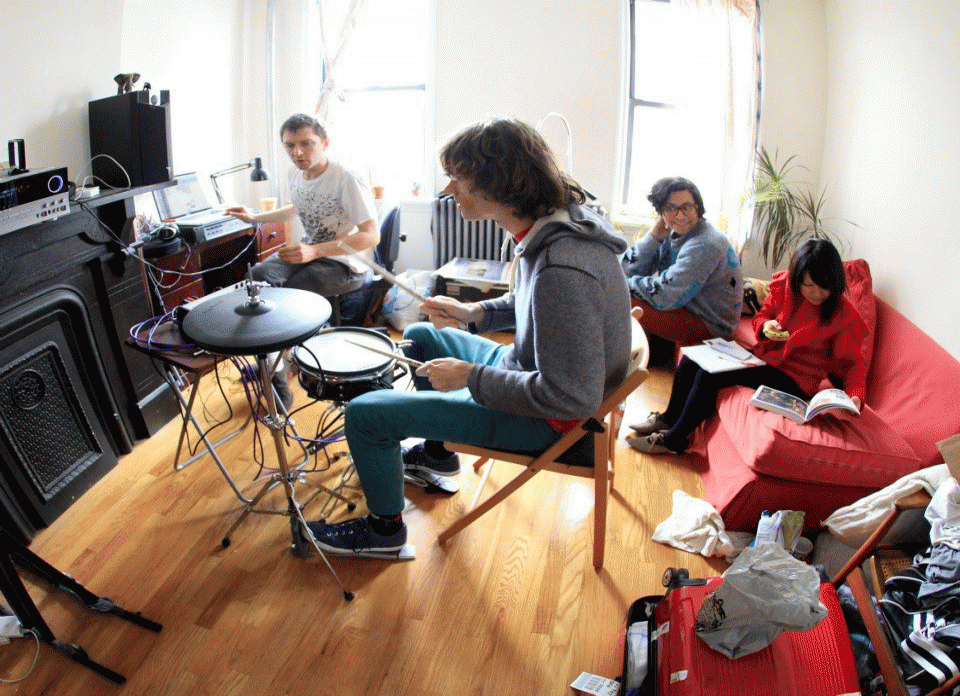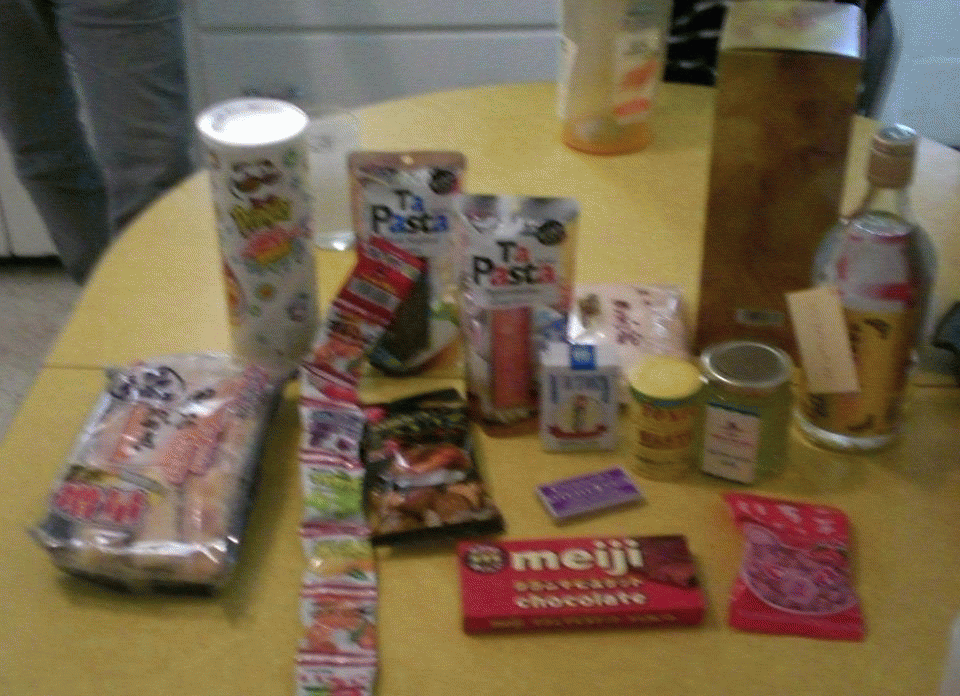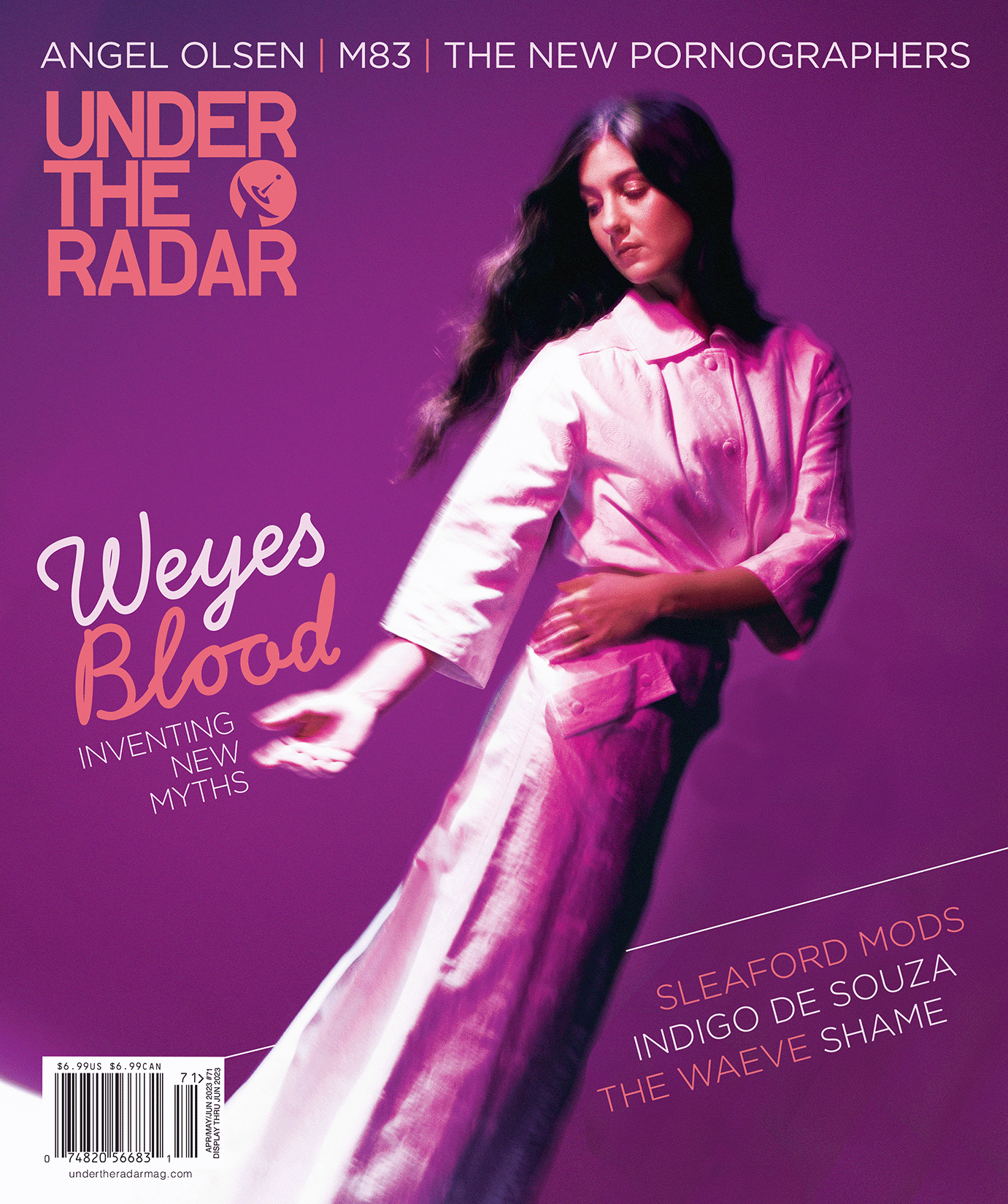
Deerhoof
Masters of Tinkering
Sep 24, 2012
Photography by Elias Gwinn
Web Exclusive
![]()
On its 12th album, Breakup Song, Deerhoof remains a band without borders. The American indie-rock group is quicksilver-y and agile while making its “Cuban-flavored party-noise-energy music.” As always, the band mixed, recorded, and produced the album D.I.Y. style and the results are delightfully rough in spots. Guitars were plugged directly into computers to remain quiet for neighbors while recording, but this is loud and energetic guitar music on record.
Per usual, Satomi Matsuzaki is a meandering and oftentimes beguiling vocalist. Her vocal tics have fused with her bandmates’ over the last decade and change so much that it’s nearly impossible to disentangle them from each other. These 14 tracks are often propelled forward by drummer Greg Saunier’s intricate rhythms. (It’s important to note that each band member has made a habit of switching instruments on and off stage.) Saunier took some time out to discuss the energetic new album, his love for The Rolling Stones, and some behind-the-scenes information on a special 7-inch single recorded during an upcoming episode of the webseries, Masters From Their Day. The single, “Sexy, By Sparkly,” drops October 23 through Famous Class. The tune was recorded with big time producer Chris Shaw (Weezer, Bob Dylan, Public Enemy) and features a B-side from art-pop upstarts, Half Waif. Pre-order it here.
Kyle Lemmon (Under the Radar): What have you been up to in preparation for the fall tour?
Greg Saunier: We’ve been rehearsing about seven to ten hours a day. Everybody showed up here Brooklyn. We’re trying to learn how to play the new songs. It’s one thing to record them through your computer. There are a lot of home-recorded tricks at your disposal, but when it comes time to actually play it and not make a fool of yourself we almost become a Deerhoof cover band. We almost have to rearrange the songs every time.
You try to keep it simple in the live setting. Does that work out well?
We always try to keep it simple on the record and fail. [Laughs] We try to keep it simple and really have no choice because we’ve only got two guitars, bass, drums, and Satomi [Matsuzaki] singing. We never bring any gadgets. We’re just a guitar rock band, you know? We’re kind of loose like The Rolling Stones. We never play a song the same way twice. When you get too many gadgets…. I didn’t just say gadgets! I sound like a conservative man from the ‘50s. [Laughs] When you have too many very specific sound effects, sequencers, or click track tracks you tend to not deviate from that prescribed tempo. It doesn’t make room for what happens in the moment. You might end up in Omaha and the audience isn’t responding to that beat. You have to be able to respond to the fluctuations in the air.
So, Breakup Song just dropped via Polyvinyl. What changes occurred during the recording of it? I heard you guys are all in different areas now, so a lot of uploading and emailing of mixes took place.
They don’t necessarily start as mixes. It could be someone strumming their guitar into their laptop microphone. When they send it you can hear stuff going on in the background. It’s pretty funny. Just yesterday, we were practicing the new songs and couldn’t get into the rehearsal space that we were borrowing. It’s shared with five other bands and it just wasn’t free. So, we were practicing at Satomi’s house with no amplifiers and no drums. [Laughs] It was this scratchy sound with no amplification and I was slapping my knees. We put some pictures on Facebook to show what that kind of practice is like. We do that all the time. Yesterday we turned on our amps for the first time and we sounded like an actual band! Hearing those new songs out loud for the first time was nice.
For instance, the last song on the record is “Fête d’Adieu” [which translates to “farewell party” from French] started out with me strumming into a laptop microphone. It was incredibly lo-fi. I asked the band what they thought of it and they like it, but what they thought I was playing was so different from the reality. The sound quality masked all that. John [Dieterich] plays the guitar riff at the beginning of the album version and he thought that beat one was in a different place than where it was. This kind of stuff keeps happening to us. If we were all in the same recording space writing the record together those kinds of miscommunications are less likely to happen. There’s also something very funny about it. All these months went by as we mixed the record and took it apart and sent arrangements back and forth. All this time John thought the beat started at a different place. I love that riff. It reminds me of [The Rolling Stones’] “Beast of Burden.” Other songs had the same problem. We had all these shocking revelations. [Laughs]
I was thinking about the title of the record and Breakup Song makes sense for that type of recording setup—you’re putting all these disparate song fragments into order. What does that title mean for you and the band?
Well, breakup songs are a subgenre of pop. Everybody’s had that happen to them and knows what that feels like. Every time something like that happens to me, I find there’s a certain kind of song that makes you feel a teeny bit better when you’re really down. We were interested in making music that is meant to be used. As a musician, you tend to forget that. You spend so much time analyzing other music and it’s hard to be innocent. I was just describing that ridiculous “Beast of Burden” comparison. It’s hard for me to hear that song and not go, “OK, the guitar riff starts on the beat before and it hits on the one. And what tune is he using in that song? Oh yeah, he’s using normal tuning where he’s normally using open tuning…” Of course the song’s about a desperate guy who really wants to have sex with a woman. It’s kind of an interesting song because it’s saying that women only want to have casual sex and they don’t want to turn it into anything serious. Mick Jagger tended to attribute a kind of confidence and sexual power to women that is unusual. That’s not what people usually claim about him or his songs.
Also, if you’re feeling down music can give you energy. It can lift you back enough so you can face the day or go see some friends. We were focused on that aspect of music making this time. We wanted to make music that people would actually use and it would give you energy when you listened to it. [Laughs] We always try to do that and it’s funny considering the type of press we get. Being called arty or avant-garde isn’t an insult because we got a lot more press than I thought. A lot of times the press is speaking on our behalf and saying we’re artists with a capital A and we don’t care what anybody thinks. In reality, it’s the complete opposite! We want to make music that people enjoy and makes them smile, sing, and dance. We were trying to do something uplifting with Breakup Song. Every song is meant to energize you. It’s personally guaranteed from the drummer of Deerhoof that if you put on any song from Breakup Song you will be inspired to activity if you were feeling lethargic before. [Laughs]
When you did record together in Greenpoint, Brooklyn?
Around 90% of the record was already recorded on four separate computers in four separate locations. We were emailing stuff. There’s no break between demos, mixing, recording, mixing, and mastering since we do it all ourselves. There are places on the record where we just strummed into a laptop built-in microphone, recorded it through GarageBand, and kept that scratchy, unamplified guitar sound in the finished mix. Anything that didn’t work we tried to make it work. I can’t even begin to describe how these songs evolved since it was totally circuitous, random. It was goofy. No pattern to it at all. When Ed [Rodriguez ] and John flew out to New York in May, they stayed for a week. The vocals had not been recorded yet and we hadn’t picked what songs would be on the record. The little things during the mixing process were difficult. There would be a snare drum that is one decibel too loud and then that change wouldn’t work with the next section of the song. There was a lot of tinkering. I was subletting at Greenpoint at the time and it was a pretty nice apartment. We had enough room to roam around and eat meals together. At no point could any of us make real noise during the recording process. It’s loud on the record, but we would just plug guitars straight into computers. I didn’t want to bother the neighbors. You couldn’t hear the electronic drums unless you were wearing headphones. [Laughs]
Yeah, my friend does the same thing when he records at his San Francisco apartment since everybody is up in each other’s business.
Right! It’s common decency. [Laughs]

I really enjoy your intricate-yet-unpredictable drumming style. I know you really love The Rolling Stones, but do you have any drummers that you admire?
How much space you got? [Laughs] I barely even know where to start! I’m stumped on that one. This is how I feel about it: When I was 14 years old and starting to play the drums, I totally was into drummers. I would listen to whatever Top 40 music and pick out the drum parts. I would air drum to records or play the drums while wearing headphones, and just play along with the song. Many years have passed since that time. For better or worse, I don’t really think about the drums any more. Sometimes I fret about how I should set up my drums or tune them.
Plus, when you’re recording you guys switch instruments a ton.
All four people played some of the drum parts and I don’t mean some random hit. John did drums one song completely and Satomi did most of another track. It’s the same with other instruments. In a way, that’s kind of what I’m getting at with this answer. Everybody plays a lot of instruments and we all have ideas of what the songs should sound like in our heads. Sometimes it’s strange when you’re not in the same city. We’re a big influence on each other since we all play the drums in completely different styles. The record’s been done for three months and in some cases I am learning to play drum parts that I did not play on the record.
So, it’s almost like you’re that kid again listening to a record with headphones and trying to figure it out.
You’re totally right! That’s a funny way of putting it. [Laughs] And you’re just as prone to get it wrong. Somebody else in the band will come marching in and play a track and it’s kind of cool that they heard it in a different way. In the end it’s not wrong. It’s probably better. It’s very likely that the version they come up with is better and more natural.

You have some excellent horn parts on Breakup Song and Deerhoof vs. Evil. Were those live instruments or computer effects?
It’s a combination. It’s never the same thing twice. A lot of the time you sit in front of the computer and try to figure out how to create in reality something you are hearing in your imagination. I can’t really answer the question. Every recording is a sleight of hand. For example, in the ‘90s I really loved those Steve Albini-recorded albums. Everyone did. Part of the reason they are so loved is because they gave you a feeling that they were so natural. That’s not true either. Those are a sleight of hand as well. It was more of an illusion than the radio songs of the day, but Albini is still making choices. Any “naturalistic” recording setup has a choice. It’s not really “naturalistic.” Even if you use one microphone, you pick that type of mic. You chose when to record and picked one take over another one. You choose how far away the microphone is from the musician. [Laughs] Because we’re D.I.Y., we can’t leave any of the variables up to the engineer or producer to figure out. We try a lot of variations before we hit on that particular sound.
After all this time, do you think Deerhoof will ever record with a producer?
Actually, I can tell you this. It’s kind of exciting. It won’t be out until late October, but we did a really cool recording for this web series called Masters From Their Day. He pairs a band with a pretty well-known producer in a real nice studio for one day. He says, “by the end of a day you should have a finished song.” It’s kind of like they did with Motown. They would go in, record, and release it to radio stations within a week. [Laughs] He was really excited about that. We had to commit the choices without going back and tinkering for ages. We ended up recording with Chris Shaw. He’s produced several of the last few Bob Dylan albums and recorded with Public Enemy, N.W.A., Beastie Boys, and Sheryl Crow. It’s unbelievable what he’s done over his career. We never met him before and just walked in.
He was so cool and had some great stories about Chuck D. [Laughs] He said that when they were doing the mixes on these songs the way Chuck D would always test it was that he would put the song on a ghetto blaster and just turn it all the way up. It was nothing but total distortion. Chris Shaw was just dumbfounded, but Chuck D was totally listening to it really close and bobbing his head. Chuck D would stop the tape and say something like, “the hi-hats too low.” Shaw would laugh and say, “whatever, I’ll turn that down.” Everybody has their funny ways of testing the music they’re working on. Chris Shaw was super great. Recording in a fancy studio with great microphones, equipment, and a real nice console was great!
Having another brain there was great as well. He would tell us to speed up a little or move the guitar placement. He was really creative and got us motivated. I’m always up for being inspired by other people or inspiring them just the same. Of course we would be interested in recording in a studio with a producer. It’s so fun, but also very expensive. We can’t afford to make a whole record with a producer. It takes too long. The tradeoff for us is that we have more time to make it work. Never say never. It’s going to be a part of the web series and we are releasing the song [“Sparkly, But Sexy”] as a 7-inch. We chose this pretty unknown band called Half Waif to be on the B-side. It’s pretty cool. (www.deerhoof.net)
Most Recent
- Strand of Oaks Shares Video for New Song “Party at Monster Lake” and Announces Tour (News) — Strand of Oaks
- Jar of Flies EP (30th Anniversary Reissue) (Review) —
- The Wake Announces New Acts For July Event (News) — Gruff Rhys, Kodiak Island, Baggio, Dominie Hooper
- Affliction (Review) —
- Johnny Marr @ Rock City, Nottingham, UK, April 14, 2024 (Review) — Johnny Marr, Gaz Coombes



Comments
Submit your comment
January 8th 2013
5:48am
Great interview! Thanks for putting it up. Greg has always seemed like an incredibly smart human.